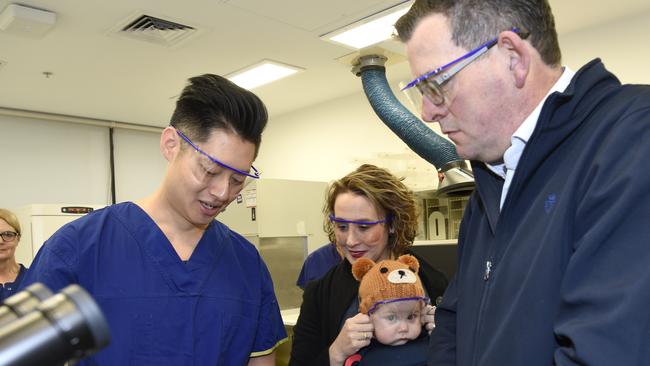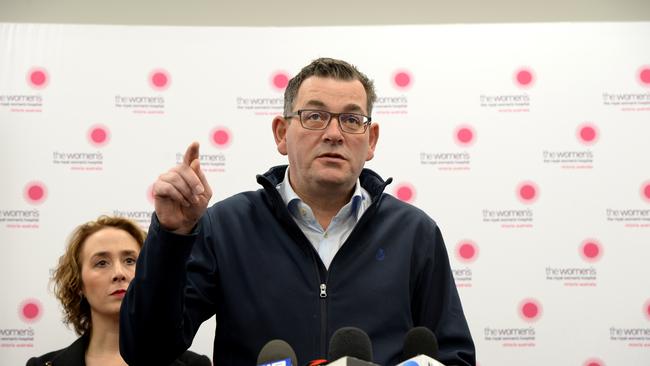FOI documents show Victorian hospitals were $300m in deficit as Covid hit
The Andrews government frequently blames Covid for Victoria’s health woes, but the documents show an underfunded system prior to the pandemic.

Victoria’s public hospitals were almost $300m in deficit and special departmental briefings were taking place to discuss how to deal with their insolvency at the point at which the Covid-19 pandemic first emerged in 2020.
The minutes of a January 2020 Health and Human Services board meeting, obtained under Freedom of Information, show Victoria’s health system was in crisis well before the first coronavirus case was diagnosed on January 25.
Dated January 21, and signed by then DHHS deputy secretary Terry Symonds, the Health Services Cash Update 2019/20 recommends that the board note the “position of the sector and the risks presented in this paper”.
The paper shows that as of December 2019, Victoria’s public hospitals were facing a $296m shortfall, including a $117m deficit at Northern Health, $42m at Austin Health, $40m at Melbourne Health, $37m at St Vincent’s and $24.7m at The Alfred.
It notes a $52m deficit in 2018-19, which came despite additional funding of $250m, and attributes the “main causes of the financial pressures on the system” to a range of factors.
These include an “increase in patient demand (beyond funded levels) which has been met with one-off funding and met with recurrent growth funding in subsequent years”, and “consecutive years of indexation passed on at only 1.5 per cent, where cost increases are considerably higher”.
“Hospitals have largely been able to find cost efficiencies to bridge this gap. However, this is now becoming unsustainable,” the department warned at the time.
Other reasons stated include cost pressures driven by new EBA arrangements, which had led to increases of more than $200m in both 2018-19 and 2019-20, as well as “additional commissioning costs of several new facilities that did not receive required funding in the 2019-20 (Expenditure Review Committee) process”, and higher reliance on the public health system rather than private hospitals.
“While hospitals continue to be asked to find savings … government continues to prioritise performance on elective, emergency and ambulance transfer, which come at a cost,” the paper states.
“Health services have proposed some measures to address the cash gap, for example initiatives to reduce demand resulting in ward closures, reduced staffing numbers, etc. These initiatives have not been supported by government to date.”

AMA Victorian president Jill Tomlinson said Covid had “significantly exacerbated pressures in a system that was already in crisis.”
“We know that there’s no slack in the system and that hospitals have always been running at capacity in Victoria. Even prior to Covid, the health system was under stress, and the pressures now on healthcare workers in terms of burnout, workforce shortages and patient demand are greater than ever,” Dr Tomlinson said, noting that workforce shortages are currently saving the government money in the short term, but costing patients.
“We need greater transparency around funding, and we need to continue to fund healthcare at a level that doesn’t condemn Victorians to suffer in pain and disability.”
In July 2019, then AMA Victorian president Julian Rait warned some major hospitals were facing funding shortfalls in the tens of millions, making it difficult to meet workplace obligations to staff.
Liberal MP and former health minister David Davis said: “It is clear that issues for which Daniel Andrews was directly responsible were the major cause of Victoria’s hospital funding crisis and that this was occurring B.C. — before COVID.
“Daniel Andrews was responsible for inadequately funding the outcomes of the enterprise bargaining agreements entered into by his government, likewise not funding commissioning costs for new facilities and inadequate and unsustainable indexation levels,” Mr Davis said.
An Andrews government spokesman said health service finances fluctuated at different points during a calendar year.
“As health services are funded based on predicted activity levels, higher than expected demand can result in temporary deficits for some health services,” the spokesman said.




To join the conversation, please log in. Don't have an account? Register
Join the conversation, you are commenting as Logout